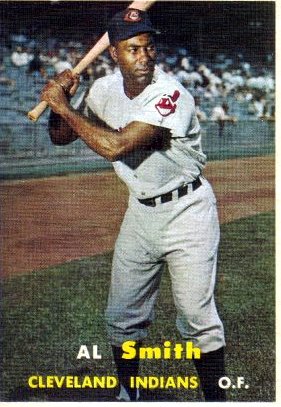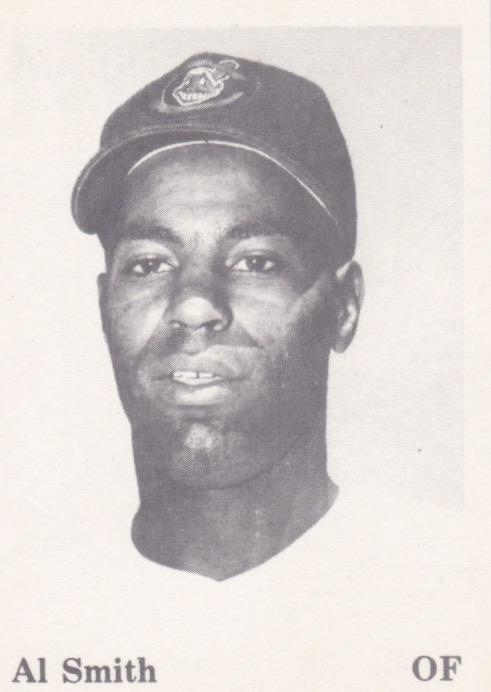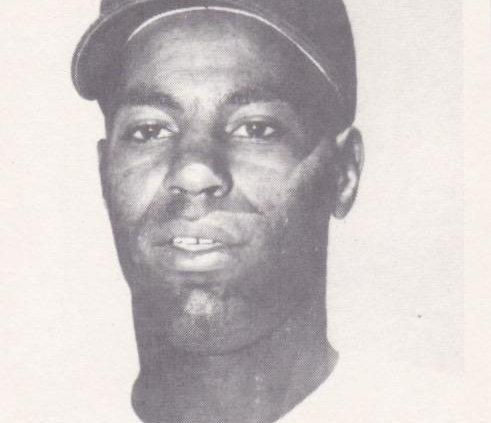Al Smith

 Al Smith was an accomplished ballplayer whose major-league career spanned 12 seasons with four American League teams. Primarily an outfielder, he played six positions as a major leaguer and was a fine defender with a strong arm and good speed. Smith finished with a .272 lifetime batting average, hit 164 home runs, and reached base nearly 36 percent of the time. He also made two All-Star teams and played for two pennant winners (both managed by Al Lopez). He hit a career-best .315 in 1960 and posted his biggest power numbers — 28 homers and 93 RBIs — in 1961. But despite his considerable on-field accomplishments, he will always be best remembered as the unwitting subject in one of baseball‘s most lasting images: the “beer-bath” photo from Game Two of the 1959 World Series. When Smith died in 2002, his obituary in the New York Times was headlined, “Al Smith, 73, Dies; Was Doused in Series.”1
Al Smith was an accomplished ballplayer whose major-league career spanned 12 seasons with four American League teams. Primarily an outfielder, he played six positions as a major leaguer and was a fine defender with a strong arm and good speed. Smith finished with a .272 lifetime batting average, hit 164 home runs, and reached base nearly 36 percent of the time. He also made two All-Star teams and played for two pennant winners (both managed by Al Lopez). He hit a career-best .315 in 1960 and posted his biggest power numbers — 28 homers and 93 RBIs — in 1961. But despite his considerable on-field accomplishments, he will always be best remembered as the unwitting subject in one of baseball‘s most lasting images: the “beer-bath” photo from Game Two of the 1959 World Series. When Smith died in 2002, his obituary in the New York Times was headlined, “Al Smith, 73, Dies; Was Doused in Series.”1
Alphonse Eugene Smith was born on February 7, 1928, in Kirkwood, Missouri, a St. Louis suburb. He grew up a fan of both local big-league teams, the Cardinals and the Browns, and his hero was Cardinals outfielder Joe Medwick. Nicknamed “Fuzzy,” Smith was a versatile, multitalented athlete at Douglass High in Webster Groves, Missouri. The MVP of the baseball team, he also starred in football, basketball, and track, and was a Golden Gloves boxing champion in the 160-pound division. Smith scored 33 touchdowns in one football season and was reputed to have scored 10 touchdowns in one game.
Upon his graduation in 1946, Smith signed with the Negro American League’s Cleveland Buckeyes. Because he was only 17, his mother had to sign his contract. In his first full season with the Buckeyes, in 1947, Smith was moved from his natural position of third base to shortstop and batted .285. He led the league with 27 doubles and 11 triples, and finished second with 12 home runs. The Buckeyes, managed by Quincy Trouppe, posted a pennant-winning 54-23 record and played in the Negro League World Series (losing to the New York Cubans). Smith changed positions again in 1948, this time to the outfield. That summer, he caught the eye of Cleveland Indians scout Laddie Placek, who had been dispatched to League Park to evaluate pitcher Sam “Toothpick” Jones. On July 11, Placek signed both Jones and Smith to major-league contracts.
Smith was sent to Class-A Wilkes-Barre in the Eastern League, becoming the league’s first African-American player. He hit .316 the rest of the way, and then .311 with the same club in 1949. Smith later said of Wilkes-Barre manager Bill Norman, “He was a thoroughbred. He said he was down there to train and get ballplayers ready to go to the big leagues and if anyone didn’t like the idea that I was playing they could get up and leave.” 2
For 1950, Smith earned a promotion to San Diego in the Pacific Coast League, where he spent the next two seasons. In 1952 Smith moved once more, this time to Indianapolis in the American Association, where he played under Birdie Tebbetts, another manager who helped Smith integrate the team. “He was the man,” Smith recalled, “When he’d tell you something you believed it. He’s the kind of guy that if he knew you played good, it didn’t make no difference what color you were. He threw all that out the window.” 3Smith finally received the call to the Indians after posting a .332 average in the first half of the season, and debuted in the majors on July 10, 1953.
Although Jackie Robinson famously broke the major-league color barrier in 1947, many teams still had no black players. The Indians were a stark exception. In ’47, then-owner Bill Veeck had signed Larry Doby as the American League’s first black player, and when Al Smith reported to the team in ’53 — by which point Veeck was gone — it had four black players: Doby, pitcher Dave Hoskins, outfielder Harry Simpson, and first baseman Luke Easter. Al Smith always held Veeck in high regard, calling him “the greatest man I ever met in baseball,” and added: “No one ever treated me better than Bill. I observed him closely and he’s one of the smartest men you’ll meet anywhere in any kind of business. A great human being, too.” 4
In 1954, his first full season with the Indians, Smith beat out veteran Dale Mitchell for the everyday job in left field. Batting leadoff, he hit .281 and scored 101 runs on a team that set an American League record with 111 wins. Game One of the World Series started with Smith being drilled in the ribs by New York Giants ace Sal Maglie. In Game Two, Smith entered the record books by hitting a home run on the very first pitch of the game, thrown by Johnny Antonelli, becoming one of only three players in major-league history to accomplish this feat. Nevertheless, the heavily favored Indians were swept by Leo Durocher’s club in four games.
In 1955, Al Smith ranked as one of the American League’s best players. His numbers included 22 home runs, 77 RBIs, and 123 runs scored, the latter figure leading the league. He earned his first trip to the All-Star Game. After the season he finished third in the MVP balloting, behind Hall of Famers Yogi Berra and Al Kaline but ahead of Ted Williams and Mickey Mantle.
Smith’s numbers fell off substantially in 1956 as the Indians won 88 games and finished well behind the Yankees. His offensive decline continued in 1957 (.247 batting average) as the Indians fell into the second division. What’s more, Smith was rankled when new manager Kerby Farrell informed him he’d be playing third base in 1958 – rankled enough to ask for a trade.
The Indians honored that request. On December 4, 1957, Smith and star pitcher Early Wynn were sent to the White Sox for Minnie Minoso and Fred Hatfield. White Sox fans were unhappy about the trade that cost them longtime favorite Minoso, and they took out their frustrations on Smith, who was booed continuously throughout that season and the next. Trying to help, White Sox owner Bill Veeck staged an “Al Smith Night” on August 26, 1959, against the Red Sox. Anyone with the name Smith, Smythe, Schmidt, or Smithe was admitted free and given a button that read, “I’m a Smith and I’m for Al”. Smith responded with a forgettable game: 1-for-4 with a strikeout, and he dropped a seventh-inning fly ball that led to a couple of unearned runs on the way to a 7-6 loss. Veeck’s plan had backfired. . . .
Or had it? The disastrous game seemed to spark Smith. As Veeck recounted in his book Veeck as in Wreck: “Over the last six weeks of the season, he led our team in home runs and runs batted in, and won game after game with the clutch hit in the ninth inning or in extra innings.”5 Like many other stories in Veeck’s book, this one is perhaps a bit exaggerated; there were only four weeks in the season after Al Smith Night, and over that span Smith batted .255 and drew exactly two walks. But he did hit six homers and drive in 18 runs, and one of those home runs did come in the pennant-clincher, on September 22 (though it was a solo shot in a 4-2 victory).
In the first game of the World Series, the White Sox beat the Dodgers 11-0 behind Early Wynn. They lost Game Two, though, which has forever been remembered for Al Smith’s embarrassing “beer bath,” a single instant that seemed to epitomize the White Sox’ frustrations throughout the fall classic. In the fifth inning, Smith drifted back to Comiskey Park’s left-field fence in pursuit of Charlie Neal’s deep drive. As Smith watched the ball disappear into the stands, a fan named Melvin Piehl, sitting in the first row, knocked over his beer and thoroughly drenched the startled left fielder. “It hit the bill of my cap and came down the side of my face,” Smith recalled. “It was in my nose and everywhere. At first, I thought the guy dumped it on purpose, but the umpire told me he just tipped it over to get the ball. I wouldn’t have caught the ball anyhow. It made the third row.” 6
In a 2000 interview, Piehl, a motor oil company executive, said he was sitting next to his wife and his boss’s wife along with a group of his company’s top salesmen. In the excitement of the moment, Piehl tried to catch the ball, he claimed, so “it wouldn’t hit my boss’s wife.” 7The incident was captured by Chicago Tribune photographer Ray Gora, stationed near the third-base dugout with a new camera developed to shoot rocket launches from Cape Canaveral. The camera was equipped with a 70-millimeter lens, and every picture it took looked like a close-up. Gora’s camera captured the mishap in an eight-part sequence that was featured in newspapers nationwide the next day. Al Smith had involuntarily played a memorable role in World Series history.
Smith kept a blow-up of the famous photo in his Chicago home, and once facetiously remarked that he had signed copies of the picture 200,000 times. At the 40th anniversary celebration of the 1959 team, Smith said of the incident that had long overshadowed his fine career, “All these years, I’ve never made a dime off of it. Everywhere I go, that’s all the people bring up. Maybe I should make T-shirts and sell them.” 8 (A remorseful Melvin Piehl shunned publicity, and once declined a guest appearance on TV’s I’ve Got a Secret.)
In any event, that was not Smith’s only memorable moment in Game Two. With the Sox trailing 4-2 in the eighth inning, Smith came up with Earl Torgeson on second base, Sherm Lollar on first, and nobody out. As Smith later told author Bob Vanderberg, “I was up there to bunt. We were trying to get runners over to second and third. I bunted and fouled it off. Bunted again, and fouled it off.” 9 With the bunt off, Smith doubled to left-center field. Torgeson scored, but the slow-footed Lollar, waved around by third-base coach Tony Cuccinello, was out at home by a lot. Smith wound up on third base but was stranded there, and the game ended in a 4-3 Sox loss, thanks to perhaps the most infamous coaching decision in franchise history.
Smith rebounded offensively in 1960, hitting .315 (second in the AL) and making his second trip to the All-Star Game. With the return of Minoso to the White Sox that year, Smith willingly moved to right field so that fan favorite Minoso could play left. In 1961, Smith continued his resurgence and hit 28 homers, his career high. But Bill Veeck had sold the team to John Allyn and Smith ran into trouble with new general manager Ed Short. According to White Sox historian Richard Lindberg, Smith balked at yet another (proposed) move to third base, and was also upset when “they asked him to work as an offseason ticket salesman for the ballclub.” 10
These ill feelings eventually resulted in a trade to Baltimore, on January 14, 1963: Smith and Luis Aparicio to the Orioles; Hoyt Wilhelm, Dave Nicholson, Peter Ward, and Ron Hansen to the White Sox. After one season in Baltimore, Smith was traded back to the Indians, his original team, but was released on August 5, 1964, with a .162 batting average in 61 games. Picked up as a free agent shortly afterward by the Red Sox, he still didn’t hit, and played his last game in the majors on October 4.
Smith had married Mildred Winston on February 12, 1956, and they remained together until Smith’s death, 46 years later. After the end of his baseball career, Smith worked for the city of Chicago, managing the park district’s baseball program, with ex-Cub pitcher Dick Drott, from 1966 through 1981. In addition to his baseball duties, he also served as supervisor of recreation at Ogden Park, on the city’s South Side, and worked as a part-time community relations representative for the White Sox. Upon retiring, he became an excellent golfer and consistently shot in the low 80s.
Al Smith died on January 5, 2002, at St. Margaret Mary Hospital in Hammond, Indiana. He was 73 and succumbed to cardiac arrest after arterial surgery. In addition to his wife, Mildred, he was survived by two sons, Al Jr. and Dan; two daughters, Deborah Bender and Maria Chalkey; a brother and three sisters; and 11 grandchildren.
At the time of Smith’s death, his White Sox teammate Billy Pierce said, “Al was a very good teammate. Al was always quiet. He never said a lot, but with his actions, he did a lot. He helped us tremendously in 1959 to win the pennant. Unfortunately, people remember him for having the beer spilled on him during the World Series, but they forgot that he drove in a lot of runs for us. He was just a very good player and a real gentleman.” 11
White Sox fans will always be grateful to Al Smith for his contributions to the pennant-winning team in 1959. But he is also fondly remembered in Cleveland. In 1993 he was enshrined in the Ohio Baseball Hall of Fame, and in 2001 was honored as one of the “100 Greatest Indians of All Time.” A fine ballplayer and a dedicated husband and father, Al Smith deserves a better fate than to be remembered simply for being doused in beer.
An earlier version of this biography originally appeared in SABR’s “Go-Go To Glory: The 1959 Chicago White Sox” (ACTA, 2009), edited by Don Zminda.
Sources
In addition to the sources cited in the Notes, the author also consulted:
Conklin, Mike. “A Wet Sox Memoir,” Chicago Tribune, April 14, 2000.
Enright, James. obituary, Chicago American, January 30, 1962.
Marazzi, Rich. Sports Collectors Digest, September 27, 1996.
Munzel, Edgar, Chicago Daily News, December 25, 1957, and March 30, 1963.
Pettica, Mike, obituary, Cleveland Plain Dealer, January 4, 2002.
Notes
1 Richard Goldstein, “Al Smith, 73, Dies; Was Doused in Series,” New York Times, January 6, 2002.
2 Rick Hines, Sports Collectors Digest (June 1, 1991): 188.
3 Hines.
4 Quote taken from article in Al Smith’s Hall of Fame file, publication and author unknown.
5 Bill Veeck and Ed Linn, Veeck as in Wreck (Evanston, Illinois: Holtzman Press, 1962), 348.
6 Goldstein.
7 Goldstein.
8 Goldstein.
9 Bob Vanderberg, Sox: From Lane and Fain to Zisk and Fisk (Chicago: Chicago Review Press, 1984), 201.
10 Richard Lindberg, The White Sox Encyclopedia, (Philadelphia, Pennsylvania: Temple University Press, 1997).
11 Patrick O’Conner, “Obituary: Al Smith Former Outfielder/Third Baseman Passes Away,” www.MLB.com (January 3, 2002).
Full Name
Alphonse Eugene Smith
Born
February 7, 1928 at Kirkwood, MO (USA)
Died
January 3, 2002 at Hammond, IN (USA)
If you can help us improve this player’s biography, contact us.


